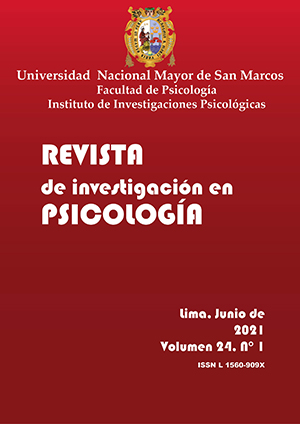Attitudes towards machismo and emotional regulation in university students of Metropolitan Lima
DOI:
https://doi.org/10.15381/rinvp.v24i1.20099Keywords:
Attitudes towards machismo, emotional regulation, public university studentsAbstract
The study analyzed the relationship between attitudes towards machismo and emotional regulation, according to public and private university and sex; In a sample of 830 students, 405 men (48.8%) and 425 women (51.2%), aged between 18 and 32 years, who were examined with a data sheet, the Scale of Evaluation of Attitudes towards machismo and the Emotional Regulation Questionnaire. A positive and statistically significant relationship is found between the cognitive reappraisal strategy with the rejection of total machismo and an inverse relationship with suppression and the six areas of machismo. Likewise, there is an association, in women, between the rejection of machismo with cognitive and inverse and significant reevaluation with the suppression in both sexes. Those from public universities obtain a statistically significant and positive correlation between cognitive reappraisal and rejection of global machismo. Those from private universities show greater rejection of machismo. The restructuring of meaning lessens the effects of stress. Although suppression modifies the expression of the emotional response but does not alter the nature of the negative emotion, leaving latent the propensity for machismo and gender violence common to all social classes and cultures.
Downloads
Published
Issue
Section
License
Copyright (c) 2021 Rosa Elena Huerta Rosales, Renato Willy Santibáñez Olulo, Natalia Luisa Ramírez Sáenz, José Manuel Vega Gonzales, Juan José Quispe Gamarra, Samira Jasmín Terrel Quiquia, Sandra Karina Gamboa Peralta, Juan Carlos Escudero Nolasco, Giovanni Chumbes Tellez, Ana Julia Gonzales Huamán, Sofía Guadalupe Merino Romero, Judith Lila Potenciano Machado, Adriana Fabiola Ortiz Mogollón

This work is licensed under a Creative Commons Attribution 4.0 International License.
THE AUTHORS RETAIN THEIR RIGHTS:
a. The authors retain their trademark and patent rights, and also on any process or procedure described in the article.
b. The authors retain the right to share, copy, distribute, execute and publicly communicate the article published in the Journal of Research in Psychology (for example, place it in an institutional repository or publish it in a book), with acknowledgment of its initial publication in the Journal of Research in Psychology.
c. Authors retain the right to make a subsequent publication of their work, to use the article or any part of it (for example: a compilation of their work, lecture notes, thesis, or for a book), provided that they indicate the source. of publication (authors of the work, magazine, volume, number and date).






